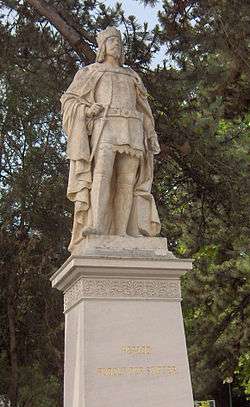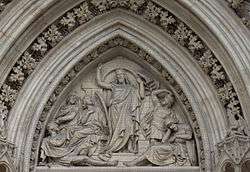Joseph Gasser von Valhorn
Joseph Gasser Ritter von Valhorn (b. 22 Nov., 1816 at Prägraten, Tyrol; d. 28 Oct., 1900) was an Austrian sculptor.


Life
He was first instructed by his father, a wood-carver, and later studied at the Academy, Vienna. In 1846 he went to Rome, where a government stipend enabled him to remain several years. On his return in 1852 he settled in Vienna. His brother Hanns Gasser was also a noted sculptor.
Gasser was professor at the Academy of Fine Arts Vienna from 1865 to 1873; among his most notable students were Viktor Oskar Tilgner and Theodor Khuen. Glasser was awarded a knighthood in 1879. Despite many public commissions, his career was neglected within his own lifetime, with little or no influence on the development of modern sculpture in Austria.
Work
Gasser's work includes:
- five heroic figures for the portal of Speyer Cathedral: Our Lady, the Archangel St. Michael, St. John the Baptist, St. Stephen and St. Bernard of Clairvaux (1856)
- the tomb of Clemens Maria Hofbauer, patron saint of Vienna, at the Maria am Gestade (1862)
- exterior figures for the Palais Archduke Ludwig Viktor, on the Ringstrasse (1866)
- statues of Maximilian I, Frederick II, Duke of Austria, and Leopold of Habsburg for the Museum of the Arsenal (1870)
- a sculptural program for the Votive Church, Vienna: the Coronation of Mary, the group of the Trinity, a figure of Christ the Redeemer, statues for the high and side altars, nine angels, and the tympany reliefs tor the three main portals (c. 1873) [1]
- seven reliefs for the Kaiserhalle, Speyer
- the marble statue of Rudolph IV on the Elizabeth bridge over the Danube Canal, Vienna, one of the eight statues now relocated to the grounds of the Rathaus, Vienna
- busts and religious figures for St. Stephen's Cathedral, Vienna
- marble figures of the Seven Liberal Arts in the staircase of the Vienna State Opera
- twenty-four figures for St. Stephen's Cathedral, Vienna
- the relief of Duke Rudolph the Founder for the New Townhall
- the "Prometheus" and the "Genevieve" for the Court Theatre
- a number of statues for the Altlerchenfelder Church
- busts of Herodotus and Aristarchus for the university
- portraits of Maximilian I of Mexico and his wife the Empress Charlotte
- a bust of the Emperor Franz Joseph I for the Hôtel de Ville, Paris
- sculptures for the New Cathedral, Linz
- exterior figures along the cornice of the Deutschmeister-Palais
References
- The new international encyclopædia, Volume 8 edited by Daniel Coit Gilman, Harry Thurston Peck, Frank Moore Colby, page 478
Sources
![]()
| Wikimedia Commons has media related to Josef Gasser. |